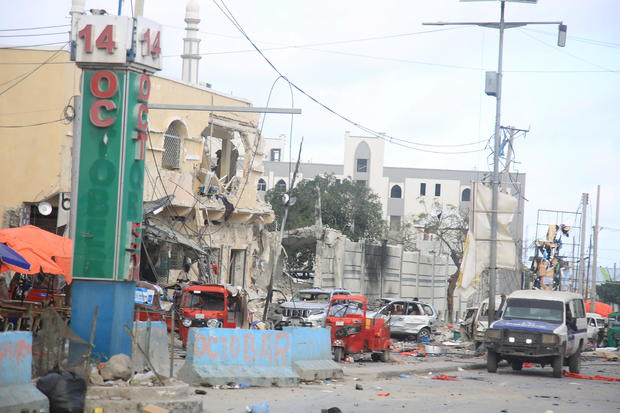Two car bombs exploded Saturday at a busy junction in Somalia’s capital near key government offices, causing “scores of civilian casualties,” including children, national police said. One hospital worker counted at least 30 bodies amid fears of possibly many more.
The attack in Mogadishu occurred on a day when the president, prime minister and other senior officials were meeting to discuss expanded efforts to combat violent extremism, especially by the al Qaeda-affiliated al-Shabab group that often targets the capital. It also came five years after another massive blast in the exact same location killed over 500 people.An Associated Press journalist at the scene said the second blast occurred in front of a busy restaurant during lunchtime. The blasts demolished tuk-tuks and other vehicles in an area of many restaurants and hotels. He saw “many” bodies and said they appeared to be civilians traveling on public transport.
There was no immediate claim of responsibility. Al-Shabab rarely claims attacks with large numbers of civilians killed, as in the 2017 blast. But President Hassan Sheikh Mohamud blamed al-Shabab by name, calling the attack “cruel and cowardly.”
A volunteer at the Medina hospital, Hassan Osman, said “out of the total of at least 30 dead people brought to the hospital, the majority of them are women. I have seen this with my own eyes.” At the hospital and elsewhere, frantic relatives peeked under plastic sheeting and into body bags, looking for loved ones.
The Aamin ambulance service said they had collected at least 35 wounded. One ambulance responding to the first attack was destroyed by the second blast, director Abdulkadir Adan added in a tweet. “I was 100 meters away when the second blast occurred,” witness Abdirazak Hassan said. “I couldn’t count the bodies on the ground due to the (number of) fatalities.” He said the first blast hit the perimeter wall of the education ministry, where street vendors and money changers were located.
The Somali Journalists Syndicate, citing colleagues and police, said one journalist was killed and two others wounded by the second blast while rushing to the scene of the first.
The attack occurred at Zobe junction, which was the scene of a huge al-Shabab truck bombing in 2017 that killed more than 500 people.
Somalia’s government has been engaged in a high-profile new offensive against the extremist group that the U.S. has described as one of al Qaeda’s deadliest organizations. The president has described it as “total war” against the extremists, who control large parts of central and southern Somalia and have been the target of scores of U.S. airstrikes in recent years. The extremists have responded by killing prominent clan leaders in an apparent effort to dissuade support for that government offensive. On Oct. 22, U.S. forces carried out an airstrike against al-Shabab terrorists who had been attacking Somali National Army forces around Buulobarde, which is located about 135 miles from Mogadishu. Two al-Shabab terrorists were killed in the strike.
A U.S. troop presence of under 500 troops has been in place in Somalia since May, when President Biden approved the Pentagon’s request to bring troops back to the war-torn country, reversing a decision by former President Donald Trump in January 2021 to withdraw the larger contingent of 750 that had been there. After taking office, Trump at first expanded airstrikes in the region, but in December 2020, he ordered a drawdown of troops. On Saturday, Prime Minister Hamza Abdi Barre said the attack would not dampen the public uprising against al-Shabab, and he and the president expressed the government’s determination to wipe out the extremist group.
This article was first published in CBS News . All contents and images are copyright to their respective owners and sources.












